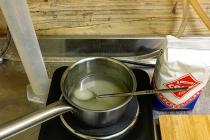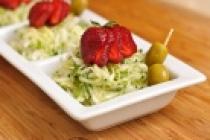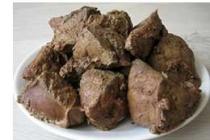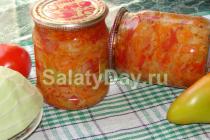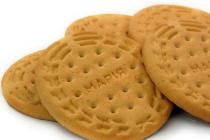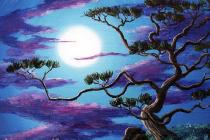French-made cognac is a product with a deep color, pleasant aroma and exquisite flavor bouquet. If you want to prepare a drink at home that will be no different from the product of an expensive brand, use caramel for moonshine. This is a natural dye made from sugar - color. Most French recipes involve the use of this ingredient to give the drink a beautiful shade.
Natural dye - properties and features
Sugar-based moonshine coloring is a safe food product that allows you to change the color of the drink.
Caramel color is resistant to acidic environments and does not change color when exposed to ultraviolet radiation. The taste of burnt sugar is felt only in two cases.
- At high concentration
- In low alcohol drinks
It is important! The use of sugar dye extends not only to cognac or whiskey. It is used to color moonshine and various tinctures.
Basic cooking rules
Caramelization of sugar for cognac and moonshine is the process of melting sugar crystals to a homogeneous consistency.
- Dishes must be absolutely clean
- The spatula should be wooden or silicone
- Do not use Teflon-coated cookware as the crystals will scratch the surface.
- The main condition is to be careful, because burnt sugar is cooked at a temperature of 190 degrees. When adding liquid, foam is formed, which can splash out at any time. To avoid burns, the liquid is heated in advance and poured into the sugar gradually, in a thin stream, along the edges of the dish.
Wet method
This method is simpler - sugar is dissolved in a small amount of water, this eliminates the possibility of burning, the prepared mixture mixes more easily with moonshine.
Required ingredients:
- Sugar – 100 g.
- Water – 130 ml.
- Vodka or alcohol – 100 ml.
- Citric acid - a few grains
Citric acid is used to give the color a more uniform consistency.
Cooking technology
- First of all, mix the same amount of sugar and water in a saucepan - 100 g and 100 ml
- Place the mixture over medium heat and heat, stirring constantly
- When foam appears, reduce the heat to low and continue cooking, stirring.
- After the water evaporates, caramel is formed and the sugar turns brown. It is important to monitor the temperature throughout the entire cooking process, as sugar can easily burn. Optimal temperature is +190 degrees. If the coloring is cooked at a higher temperature, it will become cloudy or too dark after adding to the drink.
- The container is removed from the heat when the liquid acquires the amber hue of tea. On average, it takes 12-15 minutes from the moment the water evaporates
- The mixture is cooled to room temperature, during which time the sugar hardens, several crystals of citric acid and alcohol are added to it
- The components are mixed until the alcohol dissolves the contents. If the dye does not dissolve, heat it a little, being careful, because the composition contains alcohol and can catch fire.
- There will be caramel crumbs at the bottom of the prepared syrup; this is a natural process. Add 30 ml of water to the resulting liquid, this will reduce the strength
- When the caramel stops dissolving, the dye is poured into a container for further storage.
The finished product is a concentrated sugar-based dye, the color of strong tea, with a caramel aroma.
It is important! A color prepared on the basis of dark caramel at a temperature of +190 degrees loses its taste, so it will not be possible to sweeten the drink with its help.
The finished dye is stored in the refrigerator or at room temperature. Since microorganisms are not able to process burnt caramel, the color does not deteriorate.
Dry method
You need dishes with a wide, thick bottom and high walls. Heat the dishes and gradually add sugar and stir constantly. After 10 minutes, brown foam appears and increases in volume, so a tall pan with a volume of at least 3 liters is required. The heat is reduced to minimum, after a few minutes the foam subsides. A coffee-colored liquid forms, it is poured into a metal container and, after cooling, stored in the freezer.
It is important! There is no need to heat sugar to temperatures above +200 degrees, as the sugar may burn.
How to properly add color to a drink
Caramelization of moonshine is an individual process; the amount of added coloring is determined by personal taste preferences and the desired shade of the drink. To get a product that resembles cognac in color, 2-3 drops per 1 liter are enough. The color is added to the drink, stirred, wait 5 minutes and, if necessary, repeat the process. It is not recommended to add more than 3 ml, in this case the drink will become too rich in color and the taste will change.
Now you know how to prepare natural dye for moonshine at home. Perhaps the first attempt will be unsuccessful, because experience and practice are important in this process. If the ultimate goal is to sweeten moonshine, prepare light-colored caramel, it has more sweetness.
27.04.2018
When aging distillate in barrels, distillers are often faced with the problem of the color of the drink; not everyone is happy with the light straw color characteristic of whiskey, rum or Calvados from a barrel in which another drink was previously aged. The resources of the barrel are gradually depleted, and if the taste and smell are transferred to the drink in the required quantity, the color often remains quite pale.
In commercial production, this issue is a common occurrence and it is solved with the help of color, which is added even to very noble drinks made from cognac or grain alcohols with a very long aging period.
On the back of such drinks the content of dye E150a is indicated. The “a” index says that the dye is made from sugar without the addition of third-party ingredients and a small amount of it will not harm the taste and aroma characteristics of the drink, but will affect the color, making it deeper and darker. Look at the bottles in your home bar and you are sure to find the presence of this ingredient on your favorite drinks.
Why not try to make it yourself, especially since we had several samples that could use a little color adjustment a couple of tones.
To make the color, we took 150 grams of regular sugar and 150 ml of water.
We stirred sugar in water to form a syrup and began to intensively heat it, evaporating the water. At this stage, there are small white bubbles on the surface of the syrup.
After a significant amount of water has evaporated, the bubbles increase and the syrup begins to darken.
Here you need to be careful, since the caramelization temperature should be about 190-200 degrees, and above this temperature the sugar begins to burn. Burnt sugar in the color will give unnecessary bitterness and can also cause cloudiness in the drink.
By the way, we were unable to keep the syrup within the specified range and for several minutes the temperature exceeded 200 degrees, and we smelled burnt sugar.
After reaching the temperature range, monitor the color of the syrup and after it has turned dark brown, stop heating and leave the syrup to cool to 60-70 degrees.
After cooling, add 100-150 ml of an alcoholic drink to it, which we plan to tint in the future. We added whiskey, but this color could probably be used for bourbon as well.
Try not to miss the point with the temperature, since at a higher temperature there is a danger of igniting the alcohol, and at a lower temperature the syrup becomes too hard and it will be extremely difficult to dissolve it in alcohol. It took us about 30 minutes to mix and this would probably be the longest procedure in the production process.
After the caramel has dissolved, it is recommended to lower the color level with water. We didn’t quite understand why we should do this, but we added 100 ml of water.
At this point the production process was completed, we received about 180 ml of dye. This color can be stored for quite a long time; caramel dissolved in alcohol does not crystallize and the syrup remains liquid.
To test this syrup we took
500 ml corn Bourbon 65% strength, aged for about 1 month on medium roast oak cubes,
500 ml whiskey with smoked malt, 42% strength, aged in a medium-charred oak barrel for 6 months
500 ml of ordinary clean drinking water
When using food coloring e150a, dosages of 1-3 ml per 1 liter of drink are recommended, we took 1 ml per half liter.
When adding dye to alcoholic drinks, we noticed a slight change in color; it did not change dramatically, but acquired a deeper shade. In our opinion, the addition of color did not affect the taste and smell; the initial flavor and aroma characteristics of these drinks were quite strong.
When adding dye to a control flask with water, we noticed a significant change in color; based on this change, we can judge what effect the color actually has on drinks already colored with oak. We didn’t notice any extra notes in the smell of the water, but in the taste they appeared just a little, but they appeared; we felt subtle shades of prunes and dried cherries.
To summarize, in our opinion, such a dye can be used if your drink really requires a deeper and darker color; it does not provide any additional noticeable flavor or aroma notes if used wisely. Moreover, there is no need to be afraid of using it if you prepared the color yourself; this is quite consistent with the idea of craft drinks, as prepared with your own hands, with soul and imagination.
You can see in more detail the process of preparing and testing such a dye on our channel.
Since ancient times, cooks have learned to use all kinds of food dyes in their craft. Changing the color of food is not easy, but very interesting. Warm brown shades are obtained thanks to a dye known as sugar color. In this article we will tell you how to make it and how to apply it.
Making sugar color
Making sugar coloring at home is not at all difficult. To prepare this dye, you only need sugar and, in some cases, water - nothing else.
Pour a few tablespoons of sugar into a metal bowl and place on low heat. After a few minutes, the sugar will begin to melt and bubble. You need to remove it from the heat at the moment when it acquires the desired shade of yellow-brown color. Melted sugar should be poured into a bowl made of food foil. It will be more convenient if this bowl is made square. The main thing is that it does not leak. For reliability, use two- or three-layer foil. When the sugar has cooled and hardened slightly, use a knife to make longitudinal and transverse grooves on it, trying to make the squares the same. Finally hardened sugar breaks easily along these grooves.
Application of sugar color
To color, take several squares and fill them with hot liquid, then stir until the burnt sugar is completely dissolved. The resulting brown liquid can be used to change the color of drinks, cereals, broths, dough, fondant, icing, fondant or jelly.

Sugar color is also used for coloring alcoholic beverages. cognac - the merit of this dye. On the labels it is designated as E-150. To color an alcohol-containing drink yourself, burnt sugar should be dissolved in the alcohol for which it is intended.
E-150
The food additive E-150 has several additional markings, which are written in brackets to the right of the main name. E-150 (1) is natural burnt sugar. All others are its synthetic analogues. They have the same color as natural burnt sugar, but they do not have the traditional caramel taste.

The benefits and harms of dye
Burnt sugar is no more harmful than regular white sugar. In some cases, doctors recommend giving it to children for resorption from dry cough. If we consider synthetic sugar coloring, its harm can only be noticeable if it is consumed in large quantities. There is usually little of it in food products, so you don’t have to worry about unpleasant consequences.
Since many believe that in the total mass of products that we bring from stores, the composition of artificial components is so large that our bodies do not have time to get rid of them, then in this case we can only advise one thing - to cook your own food, and use semi-finished products as less often as possible. If you learn how to make sugar coloring with your own hands, and this is not at all difficult, you will certainly find a use for it in a variety of cases.

For example, you can make the famous creme brulee ice cream. It owes its unique taste and color to the sugar color. If you prepare it yourself using the best ingredients, it will turn out no worse than the creme brulee that was made in St. Petersburg before the invention of artificial flavors and dyes.
Creme brulee ice cream
Creme brulee ice cream is a dessert that allows you to enjoy all the advantages of sugar caramel - its most delicate taste and unusually appetizing color. The natural dye sugar color, as we wrote above, combines harmoniously with different products, but the palm can be safely given to dairy products. To make ice cream, you need 4 tbsp. Pour tablespoons of granulated sugar into a non-enamelled metal bowl and melt. Boil until the caramel acquires the color of onion peel. Bring 100 ml of cream to a boil and pour into the caramel. Stir the creamy caramel and leave to cool.

Grind four egg yolks with three tablespoons of powdered sugar and combine with creamy caramel. Whip 600 ml of heavy (33%) cream with three tablespoons of powdered sugar. Combine the whipped cream with the caramel mixture and stir thoroughly. Place the creme brulee in a bowl and place in the freezer. To make the ice cream soft, you need to stir it every 15 minutes. The duration of freezing depends on the individual characteristics of the freezer. At -20 degrees, the ice cream will be ready in one to two hours.
Coloring various desserts
The solid sugar color dye prepared according to our recommendation is recommended in many recipes to be dissolved in water, but, as practice shows, this is not always justified. In some desserts, excess water has a bad effect on the taste and consistency of the finished dish. Since sugar color dissolves well in milk, and it is included in a large number of sweet dishes, it is better to use hot milk rather than water to dissolve burnt sugar.
Original ways to use sugar coloring
Sugar colors of different shades allow you to make creams, jellies and other desserts layered and decorated with elements of different tones of caramel color. To obtain sugar colors of different shades, it must be removed from the heat at different times. At the beginning of boiling, the lightest tone is obtained, one minute after boiling - medium brown, and 2 minutes after boiling, the color will begin to resemble an iodine solution. There is no need to overexpose sugar over the heat - it starts to taste bitter after boiling for a long time.

Sugar color has a unique taste that goes well not only with dairy products, but also with some fruits, such as apples and pears. It also harmonizes well with various nuts - it is no coincidence that this component is so popular among lovers of sweet grilled meats, which consists of roasted nuts and burnt sugar. By adding milk or cream and dried fruits to this duo, you can prepare the famous sorbet, which is so popular in the Middle East.
Sugar coloring, or additive E150, is a food coloring that dissolves in water. It is commonly known as burnt sugar and is used in the manufacture of confectionery products. It has a caramel taste, slightly bitter, and a burnt sugar smell. The color can range from light yellow to brown.
Color has been used for a long time. This is one of the most ancient dyes. The additive is found in almost every type of industrial product: chocolate, sweets, black bread, alcohol, dough and many others.
Why is the supplement needed?
The main function of the natural sugar coloring agent is to color foods. But the E150 additive has another purpose. It is added to soft drinks as an emulsifier - it prevents the formation of flakes and clouding of the product. Light-protective substances prevent the components of the drink from oxidizing.
The dye called “sugar color” is divided into 4 classes.
The classification is based on the methods of production and properties of the additive:
- Additive E150a (I). This is a simple caramel that is obtained by heat treating carbohydrates. In this case, no third-party substances are used;
- Additive E150b (II). It is produced using alkali-sulfite technology;
- Additive E150c (III). This caramel is produced using ammonia technology;
- Additive E150d (IV). It can be produced using ammonia-sulfite technology.
The preparation of E150 sugar color is called “caramelization”. During processing, alkalis, salts and acids are present. The main components in production are fructose, dextrose, sucrose, molasses, starch - all sweeteners are inexpensive and accessible.
Sulfurous, phosphoric, acetic, citric, and sulfuric acids can be used as acids. Sodium, ammonium, calcium, and potassium act as alkali.
Depending on what reagents are used, the charge of the dye can be negative or positive. To prevent sediment from forming, it is important to select the right dye class. To do this, take into account the physicochemical characteristics of the product.
Features of use
The natural dye has microbiological stability - it is produced at high temperatures, and its density does not allow microorganisms to develop.
Glucose is obtained from wheat, malt syrup is obtained from barley, and lactose is obtained from milk. This explains why color can cause allergic reactions. All people who have a reaction to these substances should treat the supplement with caution - the sugar color may harm them.
If the sulfite method is used, the final product may contain sulfites or traces thereof. However, this figure is very small and rarely causes allergies. Therefore, its presence is not always indicated on the packaging.
The JECFA organization has found that you can consume 160-220 mg/kg of body weight per day, depending on which class the supplement belongs to. E150a is considered safe for the body, so its daily dose is not regulated.
Is there color in cognac?
Regular cognac is made from alcohol that has been aged for 2-3 years. In order for this drink to be called vintage, it must be aged for at least 5 years. There is a special technology, alcohols are blended. But cognac contains not only alcohols.
The label must indicate that the drink contains water, sugar coloring and syrup. Sugar coloring is present in cognac in order to give it an intense color. Almost all manufacturers add it.
If a drink is prepared without this additive, it is easy to “declassify”. Cognac will have a light, yellowish tint, unsaturated and shallow. As a rule, this scares away the buyer, so such drinks are rare.
The technology for producing color is very complex; complex preparation requires some experience and includes the following main steps:
The additive gives a rich color, but does not affect the taste and aroma. In addition, it is found in cognac in small quantities.
Color is widely used in the food industry to give a marketable appearance to unattractive and unappetizing products.
Thanks to him they look bright, lively and interesting. E150 belongs to the safe class, so there is no need to be afraid of this additive, it will not harm your health.
The article describes the food additive (dye) simple sugar color (E150a), its use, effect on the body, harm and benefit, composition, consumer reviews
Other names of the additive: caramel I – plain, simple caramel, sugar color i, caramel color i, E150a, E-150a, E-150a
Functions performed
dye
Legality of use
Ukraine EU Russia
Simple sugar color, E150a - what is it?
 Simple sugar color I (E150a) is, in fact, ordinary caramel, that is, a product of thermal caramelization of sugar
Simple sugar color I (E150a) is, in fact, ordinary caramel, that is, a product of thermal caramelization of sugar Simple sugar color (E150a) is a safe food additive obtained from the thermal destruction of sugar. The process takes place in several stages, boiling down to hydrolysis (inversion) of sucrose, isomerization, dehydration and polycondensation of the resulting products. As a result, a multicomponent mixture is formed containing both small molecules of monosaccharides, hydroxymethylfurfural, and large ones - caramelan, caramel and caramel. If the original sucrose molecule and the resulting caramelan contain 12 carbon atoms, then caramel consists of 35 carbon atoms, and caramel consists of 24 carbon atoms.
In nature, the process of splitting and caramelization does not occur. Natural products contain whole monosaccharides, oligo- and polysaccharides.
In industry, the reaction is most often carried out in a neutral or acidified solution. Sucrose breaks down easily. If you leave hot sweet tea with lemon for a while and then analyze it, you can confidently say that most of the sucrose has already undergone hydrolysis.
You can caramelize dry sugar. This method is familiar to people of respectable age who made lollipops this way at home during their post-war childhood. By the way, the cockerels on a stick known to young people from films were also obtained by caramelizing sucrose. Without adding dyes they were brown in color.
Simple sugar color, E150a – effects on the body, harm or benefit?
In the human body, simple sugar coloring is gradually destroyed with the help of enzymes. As a result, simple sugars and their derivatives are formed. The original simple sugar color and the products of its transformation are not harmful if they enter the body in reasonable quantities. If you abuse products with the E150a food additive, discomfort may appear in the digestive tract. There are several reasons for this. Firstly, the overstrain of the enzymatic system by the need to utilize unexpected products in large quantities. Secondly, a large amount of glucose provokes additional stress on the pancreas.
Food additive E150a, simple sugar color – use in food products
Simple sugar color is allowed everywhere. It is used for coloring drinks, confectionery and bakery products, jellies, and jams. Additive E150a is widely used to improve the presentation of culinary products. This dye can create a wide range of colors and shades: from yellowish to dark brown. The color is determined by the concentration of the food additive.

